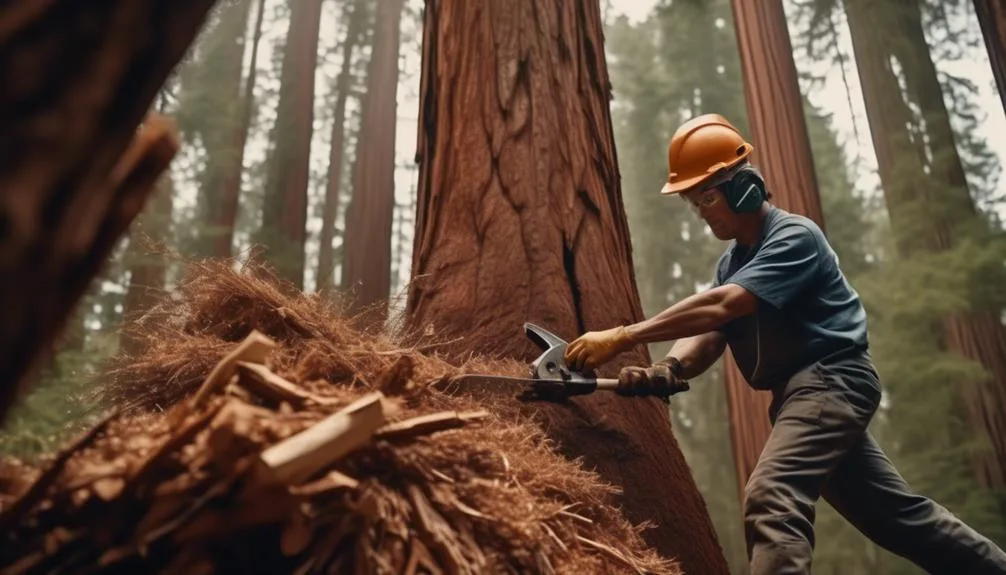Caring for redwood trees requires dedication and hard work. This includes tasks like pruning, watering, and fertilizing. But is it really a lot of work? Exploring the various aspects of redwood tree care will reveal the answer and provide insight into the time needed to maintain these impressive trees.
Redwood Tree Care Basics
To ensure the health and longevity of your redwood tree, it's essential to understand and implement the basics of redwood tree care.
Start by paying attention to the soil quality around your tree. Redwoods thrive in well-draining, acidic soil, so it's important to test and amend the soil as needed. Regularly check for signs of poor soil quality, such as waterlogged areas or compacted soil, as these can impact the tree's health.
Additionally, consider the tree's overall health by inspecting its leaves and branches for any signs of disease or stress. By being proactive in maintaining the soil quality and monitoring the tree's health, you can ensure that your redwood tree remains vibrant and strong for years to come.
Pruning and Trimming Redwood Trees
When it comes to maintaining the health and aesthetic appeal of your redwood tree, pruning and trimming play a crucial role in promoting strong growth and structural integrity.
Redwood trees have unique growth patterns, often reaching significant heights and developing wide canopies. Proper pruning techniques are essential to manage their growth, remove dead or diseased branches, and improve air circulation within the canopy.
It's important to prune selectively, focusing on removing only the necessary branches to avoid stunting the tree's growth. Regular trimming can also help shape the tree and prevent overcrowding, ensuring that each branch receives adequate sunlight and resources for healthy development.
Watering and Fertilizing Redwoods
For optimal growth and health of your redwood trees, it's essential to ensure they receive adequate watering and fertilization throughout the year.
- Watering Techniques: Redwoods thrive in well-draining soil, so water deeply and infrequently to encourage deep root growth. Use a soaker hose or drip irrigation system to ensure water penetrates deeply into the soil.
- Soil Composition: Redwoods prefer slightly acidic soil with good drainage. Consider adding organic matter such as compost to improve soil structure and fertility.
- Fertilization: Use a balanced, slow-release fertilizer specifically formulated for redwoods in the early spring. Avoid over-fertilizing, as redwoods are sensitive to high levels of nitrogen.
Pest and Disease Management for Redwoods
Managing the health and vitality of your redwood trees extends to safeguarding them against potential pest infestations and diseases, ensuring their continued flourishing in your landscape. Integrated pest and disease control is essential for maintaining the well-being of your redwoods.
Regular monitoring for pests such as aphids, spider mites, and scale insects is crucial. Utilizing natural predators, like ladybugs or lacewings, can help keep pest populations in check.
Additionally, practicing good soil management and implementing proper irrigation strategies can bolster the trees' natural defenses against diseases. Avoid overwatering and ensure proper drainage to prevent root diseases. Choosing disease-resistant redwood varieties and maintaining overall tree health through proper pruning and nutrient management also contribute to the prevention of diseases.
Vigilant care and thoughtful maintenance are key to preserving the splendor of your redwood trees.
Redwood Tree Care Time Commitment
Ensuring the proper care of your redwood trees requires a consistent time commitment to maintain their health and longevity in your landscape. Time management is essential when it comes to tree maintenance, and redwoods are no exception.
Here's what you can expect in terms of time commitment for caring for your redwood trees:
- Regular watering: Redwood trees need deep, infrequent watering, which can take up a significant amount of time, especially during dry spells.
- Pruning and shaping: Proper pruning and shaping of redwood trees require regular attention to ensure their structural integrity and aesthetic appeal.
- Monitoring for pests and diseases: Regular inspections for pests and diseases are crucial to catch any issues early on and prevent them from causing serious damage.
Balancing these tasks with your schedule is essential for the health and well-being of your redwood trees.
Conclusion
Maintaining redwood trees involves regular pruning, watering, and pest management, but the time commitment is manageable.
With proper care, these majestic trees can thrive in your landscape without overwhelming maintenance.
By dedicating some time and effort, you can enjoy their beauty for years to come, enhancing your surroundings and creating a lasting connection with nature.

My interest in trees started when I first saw the giant sequoias in Yosemite.
I was a teenager then, and I remember thinking, “I need to learn more about this.”
That moment stuck with me.
A few years later, I went on to study forestry at Michigan Tech.
Since graduating, I’ve worked in a mix of hands-on tree care and community education.
I’ve spent over ten years helping people understand how to plant, maintain, and protect the trees in their neighborhoods.
I don’t see trees as just part of the landscape.
They are living things that make a real difference in our daily lives.
